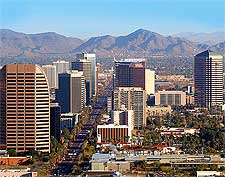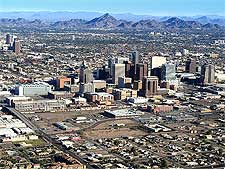Phoenix History Facts and Timeline
(Phoenix, Arizona - AZ, USA)

Located on the banks of the Salt River, Phoenix is one of the largest US cities, featuring a modern infrastructure and a rich culture. Before the start of contemporary Phoenix history however, the banks of the Salt River were occupied by Native American tribes who lived a nomadic existence.
These tribes eventually disappeared, leaving behind a legacy of imaginative irrigation systems and fertile farmland. They are known as the Hohokam, which means 'the people who have gone'. Visitors can learn more about this fascinating pre-Colombian civilization at the Pueblo Grande Museum and Archaeological Park. Alternatively, the world-renowned Heard Museum concentrates on Arizona's wider Native American history.
Foundations of a Modern City
In the early 19th century, both Spanish and American explorers passed through the region, although it wasn't until the arrival in 1857 of Jack Swilling, a businessman who had served in the military in the American Civil War, that the lands were identified for their potential. Swilling noted the Hohokam ruins and built canals following those left by the ancient civilization. In 1965, the new town of Phoenix was recognized as a place that had been born from the Hohokam ruins.
Steady growth during the 1870s meant that it had become too large for town status, and so 1881 saw Phoenix incorporated as a city. The 1880s also witnessed the arrival of the South Pacific Railroad, followed by mule-drawn trams in the 1890s. By the turn of the century, Phoenix had become a veritable center of trade.
The Early 20th Century
The early part of the 20th century saw intense political activity centered on the growing city. The signing of the National Reclamation Act in 1902 by President Roosevelt was one of the most significant events in the history of Phoenix.
This act allowed the construction of the Roosevelt Dam, in 1911, which led to the disappearance of sections of the Salt River over time, as well as the migration of some river wildlife. However, the dam provided much of the city's power and ensured a regular water supply for residents and farming irrigation.
In 1912, the city became the capital of Arizona, while the following year saw it turn to a newer form of city government, as opposed to its previous mayor-council arrangement. In 1914, St. Mary's Basilica was completed and now allows visitors to see the biggest collection of stained-glass windows in the state.

Wartime Phoenix and Beyond
During WWII, Phoenix was established as a distribution center, offering employment to local residents, as well as economic migrants. However, this period saw the emergence of racial tensions in the city, highlighted by a boxing match on Thanksgiving night in 1942, which degenerated into a mass brawl between black and white army regiments, and eventually full-scale city riots.
By the 1960s, tourists were enchanted by the city's exotic backdrop and began to flock here. The 15,000-seater Arizona Veterans Memorial Coliseum opened, hosting events such as rock concerts and basketball games featuring the Phoenix Suns. The Suns no longer play at the stadium, but visitors can still catch a game in another part of town.
The 1960s Civil Rights movement eventually ended segregation, but it meant that many middle-class whites fled the city. By the end of the 1970s, tourism had tailed off and street gangs had turned parts of the city into no-go areas, where prostitution and drug crime were rampant. Crime rates have fallen since those dark days in Phoenix history, but they are still above national averages.
21st Century Phoenix
The city center has seen a resurgence in recent times, with large numbers of bars, restaurants and shops relocating here. Meanwhile, the city's Sky Harbor International Airport has gone from strength to strength since its fourth terminal opened in 1990.
The airport has won awards for communication excellence and passenger facilities. The fourth terminal was named after Barry Goldwater, a famous political activist, senator and presidential candidate from Phoenix.
 Located on the banks of the Salt River, Phoenix is one of the largest US cities, featuring a modern infrastructure and a rich culture. Before the start of contemporary Phoenix history however, the banks of the Salt River were occupied by Native American tribes who lived a nomadic existence.
Located on the banks of the Salt River, Phoenix is one of the largest US cities, featuring a modern infrastructure and a rich culture. Before the start of contemporary Phoenix history however, the banks of the Salt River were occupied by Native American tribes who lived a nomadic existence.